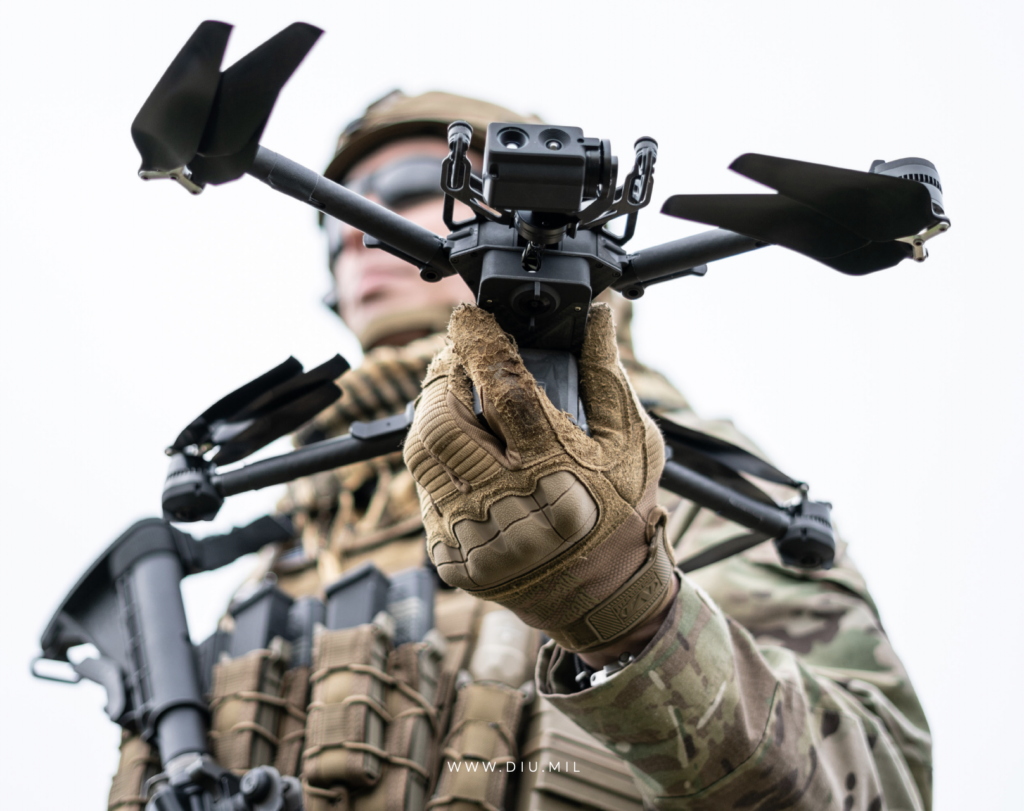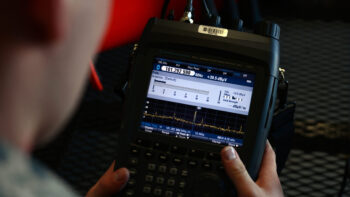
A soldier handles a commercially-developed drone acquired via the Defense Innovation Unit (DIU).
WASHINGTON: The Defense Innovation Unit keeps growing, as DIU’s newly released annual report shows – but are the Pentagon outposts in Silicon Valley and other tech hubs big enough to make a difference?
In and of themselves, experts tell us, maybe not. But as models and pathfinders for the massive Defense Department as it fumbles towards a closer relationship with commercial innovators and start-ups, on everything from drones to cybersecurity to AI-driven predictive maintenance? They just might serve as a catalyst for wider change.

Defense Secretary Ash Carter at the roll-out of the DIU(experimental) branch in Austin in 2016.
Consider some figures from DIU’s own annual report, released just ahead of its fifth anniversary in April. Created in 2015, the original DIU (experimental) in Palo Alto made its first prototype award in July 2016. From that small start, DIU had made 208 Other Transaction awards for prototyping by the end of 2020, 56 (just over a quarter) of them in 2020 alone. 34 percent of award recipients have never done work for the Defense Department before. Its projects range from AI-driven predictive maintenance on Army and Air Force helicopters to software to track air threats at NORAD to drone-operations software in use by over 200 federal organizations.
Overall, over the four-and-a-half years from mid-2016 to December 2020, DIU actually got 26 projects to the point where they were ready to enter large-scale procurement and could be handed off to other Defense Department organizations to buy in bulk. Of those 26, eleven – 42 percent – transitioned in 2020 alone, a sign that progress has accelerated over time.
Another 51 DIU projects have prototypes in the works that could transition if successful, the 2020 report says. And overall, private-sector partners have spent $11.7 billion on DIU-related work.
That’s impressive growth from nothing over less than five years. But it’s still a tiny slice of the massive defense contracting system. The official budget request for 2021 included 88 Major Defense Acquisition Programs (MDAPs) alone, each averaging just above $1 billion in procurement and R&D dollars – a total of $88.9 billion. Non-MDAPs add another $154.5 billion.
But DIU’s importance is more its example than its magnitude, two acquisition experts told us.
“DIU has grown to be the most effective ambassador of the Defense Department to that strange and foreign land called Silicon Valley,” said former Hill staffer, regular BD contributor, and lifelong acquisition reformer Bill Greenwalt, now at AEI. “Past ambassadors from the government approached the real private sector with hubris and expected tribute, conformity and compliance…. DIU has tried a different approach.” For example, DIU has reached out to companies with no experience with defense bureaucracy, allowed them to make initial proposals in five pages instead of the traditional burdensome forms, and issued them streamlined Other Transaction Authority (OTA or OT) awards instead of running them through the grinder of the Federal Acquisition Regulation.
“DIU is punching above its weight and having an impact beyond its size. Still, that will not be enough,” Greenwalt told me. “They are serving as a test bed for how to return DoD to its former innovative glory, but unless the rest of the Department and Congress learns these lessons, we will continue to fall behind China.”
The bigger impact of DIU, argued Center for Security & Budgetary Assessments senior fellow Chris Bassler, is the military officers and civil servants it has exposed to a new way of doing business and then sent back out to more traditional organizations to evangelize. “The greatest catalytic impact from DIU has been the rotation of talent into DIU and then back out to organizations across DoD,” Bassler told me. “Military and civilians who have been there bring a key perspective and experience back.”
As for the Defense Innovation Unit’s direct impact, with outposts now from Austin to Boston, it “has been effective in expanding beyond Silicon Valley and continuing to push the speed of technology adoption and prototyping,” Bassler told me. But that’s not enough: The hard part at the Pentagon isn’t finding a cool new idea, it’s finding it a place in an established, enduring Program of Record. So, Bassler said, DIU should begin to focus, not just on “adopting” new technologies as new programs, but on “ingesting” new technologies into existing, more traditional programs in the form of frequent upgrades, ideally every year.
“DIU has achieved what success they have despite the constraints that have been put on them by those in both the executive branch and the Congress,” Greenwalt said, “What is needed is a scaling up and greater support for their mission — and more flexible tools applied across the Department that are designed to enable greater partnering with some of the most innovative firms, engineers and minds on the planet.”
Australia unveils ‘historic’ defense boost to 2.4% of GDP in decade, but critics say too little, too late
Part of the shakeup includes tens of billions for nuclear-powered subs, and halting the pricey procurement of an additional F-35 fighter jet squadron.



























